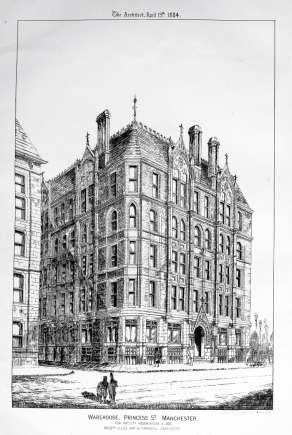George Hodgkinson Warehouse: 34 Princess Street, Manchester
The Great Depression of 1881, a global economic downturn, seriously affected the Lancashire cotton industry. All the textile towns were affected by this slump in trade, in Manchester alone there stood 50 empty warehouses and 18,632 houses abandoned by the jobless. However, the firm of George Hodgkinson of Hilton Mill, Bolton seem to have successfully overcome the difficulties. They produced quilts and quilting, manufacturing Turkish honey-combe towels, toilet covers, counterpanes and quilts or bedspreads known as “alhambras”*. The new warehouse was of five storeys, the ground floor stone faced, while the upper floors were of brick with stone surrounds to the windows and stone string courses. Steeply pitched slate roof, a typical Clegg & Knowles mixture of Classical with Gothic. Hodgkinsons occupied the ground floor with their showrooms and offices and in the basements with their packing and shipping departments. Upper floors of the warehouse were leased to other cotton merchants.
WAREHOUSE, PRINCESS STREET, MANCHESTER. WAREHOUSE, BYROM STRIEET, MANCHESTER - The buildings shown in the illustrations are among the recent works of Messrs. Clegg, Son & Knowles, King Street, Manchester. An insurance office by the same firm was lately published in The Architect. [The Architect 19 April 1884 page 247]
In 1985 the building was purchased for £500,000 by the Yang Sing restaurant. A Chinese community had begun to develop in Manchester shortly after the Second World War, the first Chinese restaurant, the Ping Hong, opening in Mosley Street in 1948. Tim Kwan Yeung, a leading dim sum chef in Hong Kong, came to England in 1968 and in 1977 he opened the Yang Sing (meaning Canton City) restaurant in Chinatown. The restaurant rapidly gained a reputation for authentic Chinese food. The 1981 Good Food Guide declared that there was "no better Cantonese restaurant in Manchester or London”. In 1983, the family business became a limited company. Two years later they purchased the Princess Street building which provided a fourfold increase in dining area.On the morning of 14 October 1997, the building was badly damaged by a fire that spread to the roof, requiring extensive restoration before the restaurant could re-open.
* A jacquard figured fabric used for bedspreads and requiring two warps. The figured warp was usually two ply and coloured, the ground warp single and white. The filling was coarse count, soft spun, often made on the waste system
Reference : Douglas Jackson, "The House that Clegg Built" Manchester Forum 21. Spring 2001. Page 2 and 16
